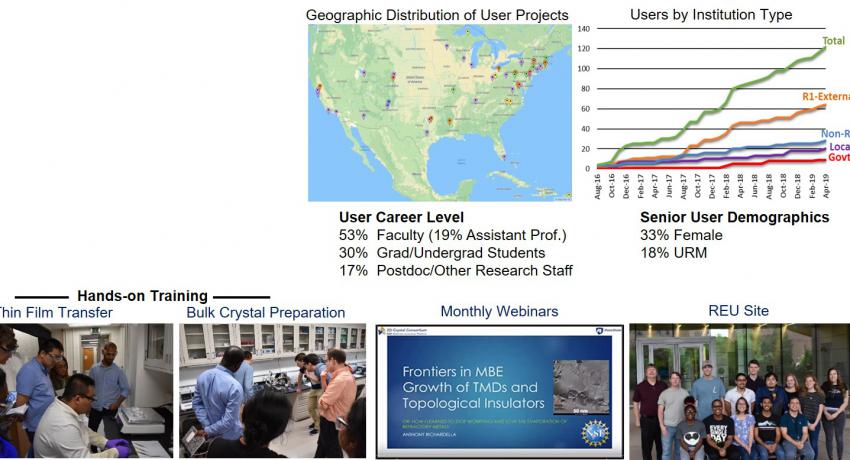What Has Been Achieved:
The 2DCC Multi-Module characterization cluster consists of a Molecular Beam Epitaxy (MBE) system connected with in-situ cryogenic Angle Resolved Photoemission Spectroscopy (ARPES) and four-tip Scanning Tunneling Microscopy (STM) tools. Samples can be transferred directly into the characterization tools, without exposing them to atmosphere, allowing the properties of pristine surfaces to be studied. This allows the quickly characterization of sample’s inherent properties and the rapidly development and optimization of new 2D materials and heterostructures. Ports for seven thermal effusion cells and a six pocket e-beam evaporator allow a wide range of materials to be fabricated. In-situ Reflection High Energy Electron Diffraction (RHEED) and spectroscopic ellipsometry allow real-time characterization of films as they grow. The MBE system can grow on up to 2 inch wafers. An adaptor to flag style holders allows growth on up to 1 cm2 substrates that can be transferred in the ARPES and STM modules. The nanoprobe STM features 4 independent tips that can be used for 4-point in-situ electrical transport measurements down to 4.5 K. The integrated scanning electron microscope (SEM) can be used to position each tip independently over chosen features of the sample with a resolution better than 1 micron. Each tip is capable of scanning tunneling measurements although currently only one tip can be used for STM at a time. A small superconducting coil under the sample stage can produce magnetic fields up to 200 gauss. Argon sputtering is available for tip and sample cleaning and preparation. The cryogenic ARPES module features a high intensity helium plasma source and monochromator, allowing energy dependent characterization of films with He 1 or He 2 photon excitations down to a sample temperature below 20 K. The high resolution spherical analyzer can resolve down to 1.8 meV using a 2 eV pass energy. Base pressure is 3 x 10-10 mBar.
Importance of Achievement:
The multi-module cluster tool enables 2D chalcogenide films to be grown by MBE and directly transferred into the ARPES chamber for electronic structure characterization and the 4 probe STM chamber for surface characterization and transport measurements. The system also includes a connection for a vacuum suitcase enabling sample transfer from other thin film growth equipment in the 2DCC. The equipment is accessible to external users through the 2DCC User Program.
Unique Features of the MIP That Enabled Project:
Ability to support technical staff with specific expertise in chalcogenide MBE growth and ARPES/STM who maintain and use the equipment for in-house research and work closely with external users on training and materials growth.
Credits/Names: Nitin Samarth, Anthony Richardella (Penn State)
Download PDF Version: UserFacilitiesMultiModuleWord TemplatePDF.pdf
Year of Research Highlight: 2019
Select a Highlight Type: Broader Impact Highlight
